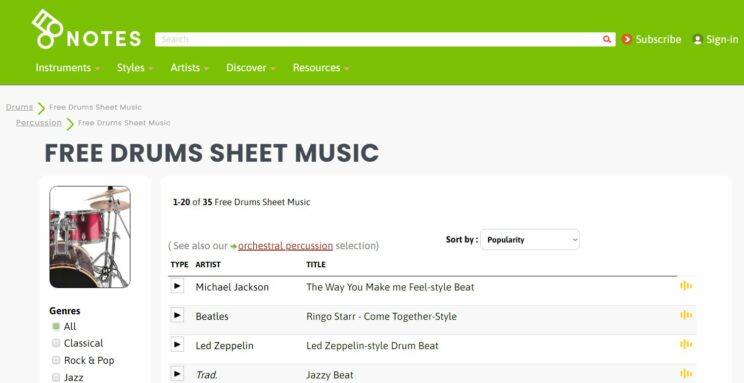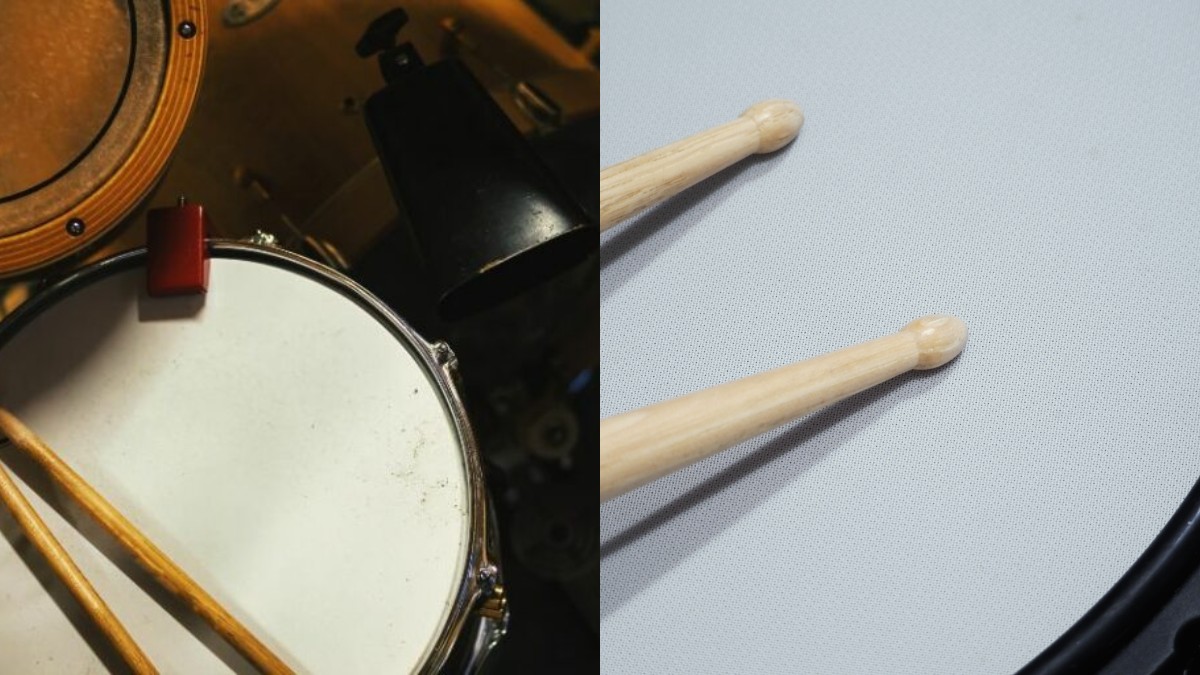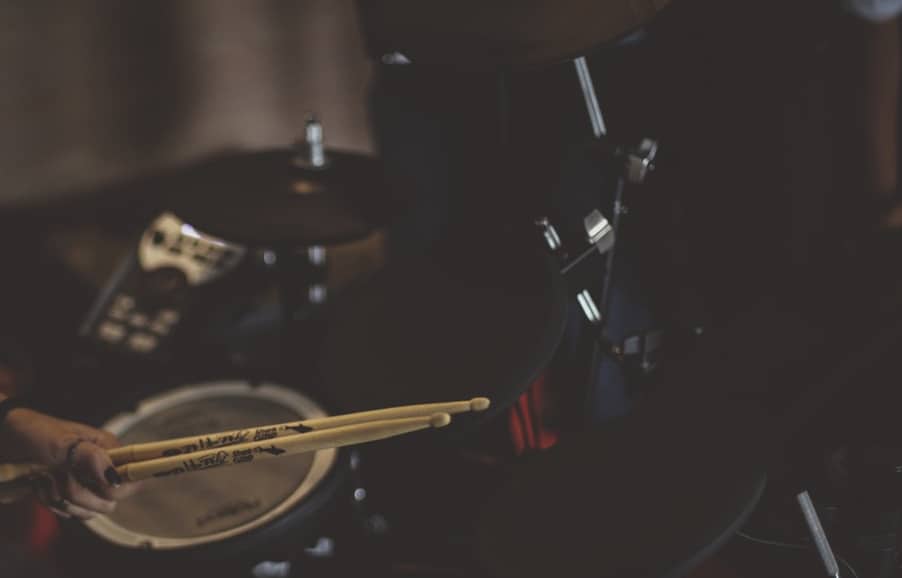How to Read Drum Sheet Music – An Easy Guide (2024)

It’s pretty easy to learn the basics of drum sheet music. For drums, all you need is to grasp the basics of music notation and a few examples to get started. After that, it’s just a matter of practice!
I’m a real ‘learn by doing’ guy, and many drummers are also. In this article, I’m going to show you the basic approach and an example rather than driving you away with heavy music theory stuff. You can learn the details of music theory later. Once you get a bit of a context of how to read sheet music, then you can quickly get moving from there.
Without further ado, let’s dive in!
Contents
Reading Drum Sheet Music – The Basics
Understanding the Staff
The easiest way to approach is to first remember that like any piece of sheet music, there is the staff, which is the 5 lines. Within these 5 lines, you would see notes placed on different heights of the line.
The drums and cymbals are arranged in the following order on the staff, roughly with lower pitched drums being lower down on the staff. I’ve included most of them below, but in most cases you can ignore many of the extra percussion instruments (tambourine, wood block, etc!) for starters unless you plan to use them.
Note: Drum parts are written as dots/notes and cymbals are written as ‘x’ (as you can see below). Note the legend below has ‘electric snare’ written below, but this note applies to both acoustic and electric snares!

Now that you know what it looks like, let’s go over a few other crucial points.
Time Signatures and a Bar
Time signatures are written at the start of the line (left), with the most common one being 4/4. If we take 4/4 as an example, the top number (4) tells how many beats occupy a particular bar. The vast majority of music is written in this time signature and it’s easy to clap along to.
The below bar contains 4 notes, these are quarter notes (i.e. each of them take up a quarter of a bar), so each stroke will be exactly on the beat, alternating between the bass and snare drum.

Notes and Counting
To further understand how to read drum sheet music, you must first learn what type of notes there are and how they work.
We’ll explain it at a high level and then you can watch and listen to the examples below. Without going into too much detail, there are many different notes but we will focus on the most common ones and those are the whole note, the half note, the quarter note, the eighth note, and the sixteenth note.To explain the concept of note values in the simplest way, if we set each up in a 4/4 time signature and use counting then each note would be like this:
Whole Note: Lasts 4 beats (the entire phrase).
Half Note: Lasts 2 beats (half of the phrase).
Quarter Note: Lasts 1 beat (a quarter of the phrase).
Eighth Note: Lasts 1/2 beat (an eighth of the phrase).
Sixteenth Note: Lasts 1/4 beat (a sixteenth of the phrase).
The concept of counting and beats is simple, for example, a whole note (4 beats) means that when played lasts the entire phrase – meaning 4 seconds long and so on for each of the others. This is where the bottom number comes in. The bottom number indicates the value of each beat – meaning that if there are 4 beats then each beat is a quarter note.
Now, let’s get into more visual representations and the basic rock beat.
A Simple Rock Beat
Take this example (automatically starts at 1:24) of a basic rock beat. This piece is a great way to explain how drum sheet music works, as it uses a very simple rhythm with multiple different surfaces.
Quick explanation:
- There are 4 beats in a bar here: This particular piece uses the same time signature as the vast majority of modern music, which is 4/4 – which means that there are 4 quarter notes per bar (more on that later). Many bars together are combined to make up a song.
- The different drums and cymbals are placed in different vertical positions of the staff.
- The kick drum is at the bottom, the hi-hat is an X at the top, and the snare drum is above the middle. Drums are written as regular music notes, while cymbals are denoted as X’s.
- In this piece, all the kick and snare hits are on the main beats (1, 2, 3, 4), but the hi-hats are also played evenly between each of these beats as well (1 & 2 & 3 & 4 &). These are known as eighth notes, as they have half the value of quarter notes (so they occur twice as much in our piece).
It’s very useful to play along using a metronome when trying these out. This helps to ensure that you’re staying exactly on time, and it helps when you get into more complicated rhythms.
Mixing it up a little
Now let’s change it around a little. Take a look at the next beat in this video (automatically starts at 2:47), we’re simply moving the bass drum from the 3rd beat one-eighth note forward.
This kick drum hit occurs exactly at the same time as our hi-hat hit in between the 3rd and 4th beat.
One little change to our bar has made all the difference. Feel free to try out different arrangements yourself. You can have a snare drum, bass drum, and hi-hat hits all at once if you want.
I recommend that you start slow when doing this. This video is a great example, as it starts at 60 beats per minute, exactly one beat per second.
Once you increase the speed, these drum beats can get very cool.
I initially thought “What’s the point of sheet music for drummers” when I started to play drums. After a few drum lessons, I really started to see the difference.

Learning a basic rock beat is easy for drums, but it’s very easy to plateau with your learning development on drums.
One of my best and most important pieces of drum tuition was Dom Famularo’s drum tuition book ‘It’s your move’. I would have never been able to even read the instruction if I didn’t know how to read drum sheet music.
Learning drum notation does the following:
- It gives you a better understanding of music and rhythm.
- Opens you to a whole new world of music tuition, books, and learning resources.
- Enables you to read and play on the spot, meaning that you don’t have to learn large pieces of music for performances. This is great for session drummers, or for drummers in cover bands that need to refresh their memory on songs regularly.
- It gives you more credibility as a musician.

Difference between Drum Sheet Music and Drum Tabs
The easiest way to explain this is that drum tabs are much easier to read than drum sheet music. Where sheet music fall under the category of music theory and involve much more complexity, drum tabs are way simpler and easier to comprehend because each part of the drum set is better and simply depicted. To understand more about this, check out this article about drum tabs.
Learning more of the basics
Take a look at this next video to keep learning the basics:
After this, I’ve listed some more quick resources that you should check out straight away. These include more resources to learn how to read sheet music for drummers, and links to free sheet music for download.
Rob from DrumsTheWord does a great job of explaining more of the basics here.
Free drum sheet music
There is a wealth of free drum transcriptions on the web. Here is a great list of options for you to get started right away without having to pay a dime:
http://www.drumscore.com/sheet-music/free-drum-sheet-music – Drumscore.com is a fantastic resource for sheet music. I’ve linked to a page which includes a list of their free transcriptions. This includes a few cool metal tracks in here too, such as System Of A Down and Iron Maiden. Rock on!

https://www.8notes.com/drums/sheet_music/ – This site is only free for a few scores per day, but there is a great selection. It also includes a play-along element which is a great plus.
That should be enough free resources to keep you going! If you have any other links to add to the list then please write a comment below.
Final Thoughts
There are many benefits to learning how to read sheet music. More and more musicians in modern days are self-thought. If you’re in this category, then good for you. However, you need to push yourself towards all of those important aspects of your music education to ensure that you keep learning and keep progressing.
My biggest takeaway is this: try to recognize when you stop progressing on drums. A few years ago, I was practicing hours a day, but I realized that I wasn’t putting quality time into my practice. I was just sitting on my drum set and rehashing the same drum beats over and over again.
Take it from me, if you have a drum kit, then you need to diversify your practice sessions. Try adding a drum fill, experiment with a different or new groove, implement some triplets, or even increase the BPM (change the tempo). There are free drum lessons across the web to assist you.
Learning how to read sheet music for drums can put you in the zone of trying out new rhythms there and then. It’s a great learning adventure to pick up a drum tuition book and start playing rhythms and different grooves.
Drum sheet image/legend by: Hyacinth at the English Wikipedia, CC BY-SA 3.0, via Wikimedia Commons









Hi, I would like to report DrumScore. A free resource for drummers where you can find many drum sheet music. The application allows you to create new grooves and fills and share them in order to encourage the studying and learning drum. His address is https://drumscore1.azurewebsites.net/